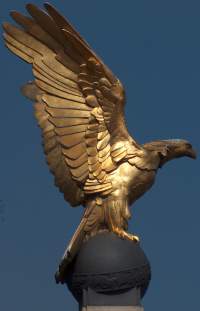
Sculptures or statues of eagles are fairly widespread. In terms of their allegorical significance, the eagle sculpture today is associated closely with America, but this was not the case in Victorian or Edwardian England, despite the bird having been the national emblem of the United States since 1782, and appearing in American sculpture ever since in the sense of being engraved in low relief on the coinage. Looking at the various allegorical representations of America in Victorian sculpture, however, we find above all the buffalo as the symbolic animal, and the eagle is absent. For examples of eagle sculpture representative of America in London, then, we need to look at America’s representation of itself in the shape of the American Embassy in Grosvenor Square.
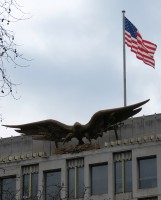
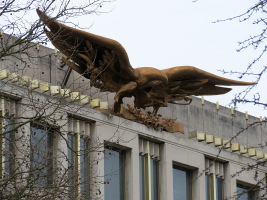 United States Embassy Eagle, by Theodore Roszak.
United States Embassy Eagle, by Theodore Roszak.
This beast is massive, with a 35 ft wingspan, and though it is the right kind of eagle (which is to say the American Bald Eagle, rather than the Golden Eagle), given its late 20th Century date it is stylised; nor does it carry in its beak the familiar 'E Pluribus Unum' motto, or the sheaf of arrows in its claws, familiar from other versions of the USA symbol. The eagle is gilded, apparently Aluminium underneath (reasonable to keep the weight down on such a large sculpture), and the sculptor was Theodore Roszak, a 20th Century Polish-American artist most familiar from his Constructivist work, both sculpture and on paper.
Before the USA entered WW2, American fighter pilots flew alongside British ones in the Royal Air Force Eagle Squadrons, and a memorial to them in the square has a second eagle. Rather stylised, it is painted in black and white, the colours of the mature Bald Eagle. Elizabeth Frink was the sculptor.
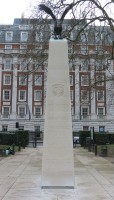
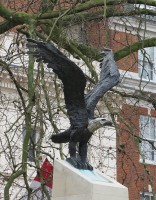 Eagle Squadron Memorial, Grosvenor Square.
Eagle Squadron Memorial, Grosvenor Square.
The American eagles do of course hearken back to earlier uses of the eagle in sculpture: thus the Embassy eagle sculpture has its wings spread, as a symbol of freedom. The Eagle Squadron memorial eagle statue has its wings raised, because the symbolism is courage and fierceness, rather than freedom per se. In the various other eagle sculptures across the country, I think it is fair to say that the ideal of courage is the more frequently represented. In the armed forces, in Britain as in America, it is of course the Royal Air Force which has appropriated the eagle, as in the magnificent Golden Eagle on the Royal Air Force Memorial on the Victoria Embankment, the work of the prolific sculptor W. Reid Dick, shown below and at the top of this page.
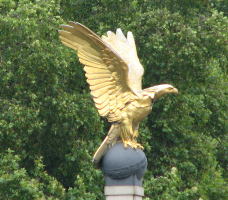 Royal Air Force Memorial, by W. Reid Dick.
Royal Air Force Memorial, by W. Reid Dick.
A straightforward allegory of Courage is shown in the panel below, which is one of the panels on the exterior of the Manchester Art Gallery, with freestanding and attached statues forming a group containing both eagle – a rather stiff one in this case – and a lion. The sculptor was John Henning Jr.
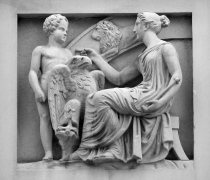 Eagle as allegory of Courage, by John Henning Sr.
Eagle as allegory of Courage, by John Henning Sr.
Watchfulness is another attribute of the eagle, thus the Eagle Star Assurance building in Manchester, on the corner of Cross Street and King Street, bears great stone eagles, wings as if being raised prior to take off, head lowered and thrust forwards with the characteristic ‘eagle glare’, thus symbolising the eagle eye that institution kept on the fortunes of its policyholders; the second example from the same building has the neck craned round as the eagle spots something unexpected. And the remarkable Coroners Court and Fire Station, also in Manchester, has eagles high up, standing on globes, watchful for the security of the inhabitants of the metropolis. They are the work of the inventive J.J. Millson, and show the birds – recognisably Golden Eagles – with wings partially spread, providing fine silhouettes against the sky.
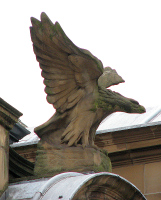
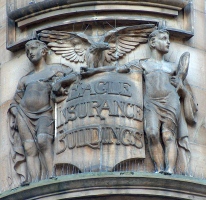
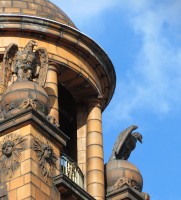 Watchful eagle statues in Manchester - Eagle Star Assurance, and Fire Station.
Watchful eagle statues in Manchester - Eagle Star Assurance, and Fire Station.
Here we have another institutional eagle, from a bank, rather awkwardly perched but with fine muscular decoration, rather heraldic, again used in the sense of the watchful eagle.
Of course eagles can be simply decorative too. Below left is a rather modern panel showing a highly stylised eagle, with almost parrotlike beak, as a decorative element. Another panel, below centre, adds a touch of verve to a pub; this example being presumably from mid-late Victorian times, but again with a sense of graphic simplicity almost as if in heraldry. Below right we have an eagle as architectural support to a ledge, a bracket if you will. Again in stone, this one is carved with delicate small feathers to breast and neck, reducing to a rather lizardlike texture to the head; the larger feathers on the wings are treated in fanciful clusters putting representation entirely subordinate to the decorative requirement.
There are many such small eagles used as architectural adornments. Below left, eagles are perched at the tops of pillars to fill part of the entablature in a pleasingly three dimensional pattern. Next, we have a pair of eagles above a window, flanking a roundel enclosing a snarling bear’s head, to give a pediment effect. The eagles are rather fluffy, chickenlike creatures with their undersized wings and beaks, but excel in the downiness imparted to the feathers, especially on the legs. The material is a pale terra cotta. Then we have an eagle filling a double spandrel (lots more spandrels on this page), with a Gothic, outstretched head. And the example to the right is a rather heavy stone specimen adorning a wall.
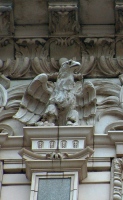
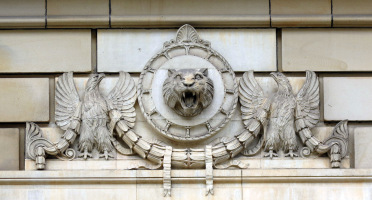
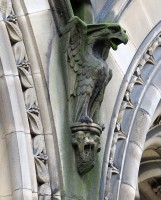
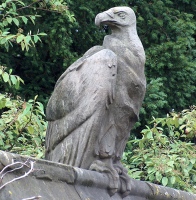 Eagles for architectural decoration.
Eagles for architectural decoration.
Eagles can also be used as free standing termini of pillars, as in the typical example below left, a rather sketchy, unfinished beast, which nevertheless captures considerable fierceness in the beak and head. The example below right has an eagle surmounting a pediment, which in contrast is fairly highly finished. The wings of the first example are held close to the body, to avoid their breadth exceeding that of the pillar itself, and looking top heavy. For the pediment, a wider span is appropriate, to give a more satisfyingly broad adjunct to the wide, flat architectural space below.
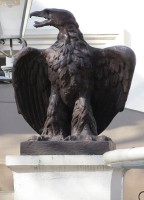
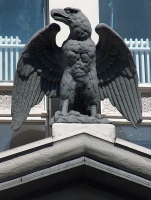 Eagle as a terminus to a pillar, and summit of a pediment.
Eagle as a terminus to a pillar, and summit of a pediment.
We should mention at least in passing the double-headed eagle, typically heraldic, and below is a rather early example of a roundel bearing such a bird, in fine red sandstone.
There was a time when eagle fonts were fairly widespread, and these would be decorative and practical, using the wings as a rest, rather than allegorical, as the church would hardly wish to be associated with fierceness, and although courage might be appropriate, this would tend to favour a more passive allegory than the aggression of the eagle.
The religious eagle is also found along with the winged bull, as in this example with outstretched wing and bearing a halo, below left, and with angel and winged lion surrounding the steeple of the Agapemeni Church, Stamford Hill, by the sculptor A.G. Walker.
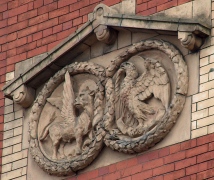
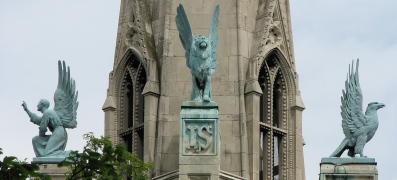 Eagles in religious iconography, with winged bull, and from the Agapemeni church.
Eagles in religious iconography, with winged bull, and from the Agapemeni church.
We should end by noting that there are examples of naturalistic eagle sculptures. The quintessential example, to my mind, is the Japanese Eagle statue in the pond in Queen Mary’s Garden, Regents Park, an exquisitely crafted piece, with a particular fierceness familiar from Japanese art of the 19th Century.
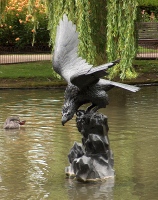 The Japanese Eagle statue in Regents Park.
The Japanese Eagle statue in Regents Park.
Visits to this page from 13 Mar 2014: 4,924 since 3 October 2022
Lion sculpture // Other animal sculpture // Allegorical sculpture